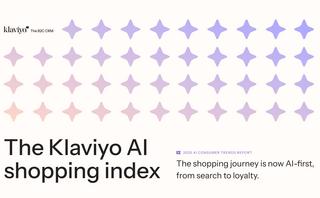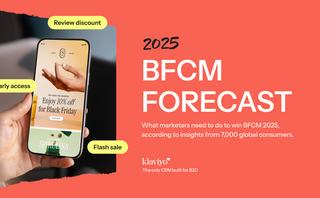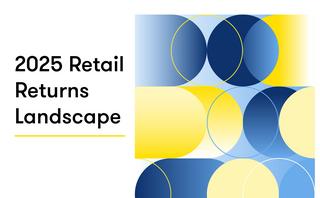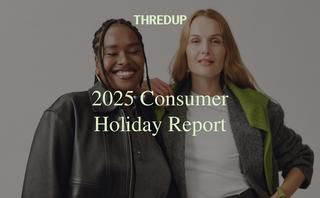703 notes tagged as ["Customer behaviour"]
Filter your results by choosing one or more tags below or type your query in the search field above.
-

Four out of five consumers have used AI for shopping or product research in the last three months. Find out what that means for your business with our latest report, featuring fresh insights and strategic recommendations.
Read your copy of the Klaviyo AI Shopping Index to discover:
How AI-native brands grow differently (and why they’ll win)
Why other AI platforms can’t keep up with Klaviyo
How AI supports marketers and drives more revenue
-

The yearend holiday shopping season may mean half of consumers tapping BNPL for purchases. Half of holiday shoppers plan to use buy now, pay later services to cover their expenses this holiday season, according to a holiday survey of 1,000 U.S. adults from digital payments provider PayPal Holdings. The respondents cited budget control and affordability as the top reasons for using the payment tool.
-

From shifting loyalty to year-round gifting, learn what’s driving global purchase behavior in 2025—and how top brands are building smarter, more profitable campaigns in response. Packed with trends and actionable tactics, this report helps brands capture more revenue through smarter segmentation, loyalty, and omnichannel orchestration.
-
You are currently enjoying the free trial mode which gives only back 3 results for each of your searches.
Click on Reset Search Tags to try another search.
Free NewsletterOnly paid members can get full access to the most recent content, create their own tags & personal folders, assign search results to specific projects and much more… all of this for less than 99c a day.
-

2025 Retail returns landscape
Returns are growing in importance — with both retailers and consumers. To understand how these pressures are shaping the retail landscape, the National Retail Federation (NRF) and Happy Returns, a UPS company, explored both consumer and retailer perspectives and priorities for the returns experience. Key findings include:
Total returns for the retail industry are projected to reach $849.9 billion in 2025.
-

Gen Z, millennials drive adoption of AI for holiday shopping
Those groups are harnessing artificial intelligence for gift ideas and to compare prices this season, a new survey states. While nearly a quarter (23%) of consumers overall are likely to use chatbots and AI tools to shop this holiday season, millennials and Gen Z shoppers are leading the way in using the technology, according to an Epsilon Pulse report. Forty-four percent of millennials and 42% of Gen Z respondents said they are likely to use chatbots and AI tools for holiday purchase inspiration.
-

New data reveals shifting consumer attitudes toward app data sharing and advertising
Verve has released its [In-app user privacy report 2025](https://www.businessofapps.com/in-app-user-privacy-report/?utmsource=newsannouncement&utmmedium=download&utmcampaign=verve-hosted-download-engagement)_, a comprehensive study surveying 4,000 mobile users across the US and UK. The report examines evolving consumer attitudes toward data privacy, personalized advertising, and the value exchange between users and publishers.
-

What’s next for DTC?
AI is the biggest fundamental shift that will change the way DTC brands serve ads and how shoppers shop from DTC. When you think about where direct to consumer (DTC) came from, it started with a simple concept: Anyone could come up with an idea and create their own online store. Then in the mid-2000s, e-commerce platforms like Shopify made it easier for anyone to launch an online store. And social media giants like Facebook (now Meta) gave brands new ways to reach customers directly, and that’s really where this whole world was born.
-

40% of holiday budgets will go to secondhand gifts
ThredUp, one of the largest online resale platforms for apparel, shoes, and accessories, today released its 2025 Holiday Report. The study, conducted by GlobalData and surveying 2,000 consumers, reveals that despite economic uncertainty, holiday spending remains resilient, with a major shift to circular shopping: consumers plan to dedicate nearly 40% of their total holiday budgets to secondhand gifts, up from the 30% they typically spend on resale in their everyday shopping.
-

Consumer sentiment & behaviour trends in 2025
What are the trends shaping consumer sentiment and behavior in 2025—and what are the implications for brands and retailers? People are spending more of their time alone and online. Gen Zers don’t feel financially secure but are willing to splurge. In their search for value, shoppers are buying smaller pack sizes or lower quantities of their preferred brands.
These are some of the trends highlighted in McKinsey’s ConsumerWise research on consumer sentiment and behavior, drawing on a survey of more than 25,000 consumers in 18 countries. Two ConsumerWise leaders discussed the findings on a recent webinar, excerpts of which are featured in this episode of the McKinsey on Consumer & Retail podcast, hosted by Monica Toriello. An edited transcript follows. (For ConsumerWise insights about the upcoming US holiday shopping season, read “ An update on US consumer sentiment: Settling in for a tepid holiday season,” and the related podcast episode, “ Holiday shopping 2025: US consumers hunt for early deals.”)
-

Consumers embrace AI for research, but few have allowed it to make purchases
Customers are worrying over payment security, privacy and potential mistakes with autonomous AI purchases, a Riskified survey found. Nearly three-quarters of global consumers say they are using AI in their shopping journeys, according to a survey of more than 5,000 people released Monday by Riskified.
Only 13% of consumers say they’ve had an AI complete a purchase after it guided them to a website, but 70% say they feel at least somewhat comfortable with an AI agent making purchases on their behalf.
-

Consumers increasing holiday spending on secondhand gifts
Secondhand shopping will help drive sales this holiday season as shoppers plan a sharp increase in the percentage of their budgets allocated to resale. Consumers plan to allocate nearly 40% of their total holiday budgets to secondhand gifts, up from the 30% they typically spend on resale in their everyday shopping, according to online resale platform ThredUp’s “2025 Holiday Report.” And 66% of all respondents are open to giving secondhand gifts, a figure that jumps to 80% for millennial respondents.